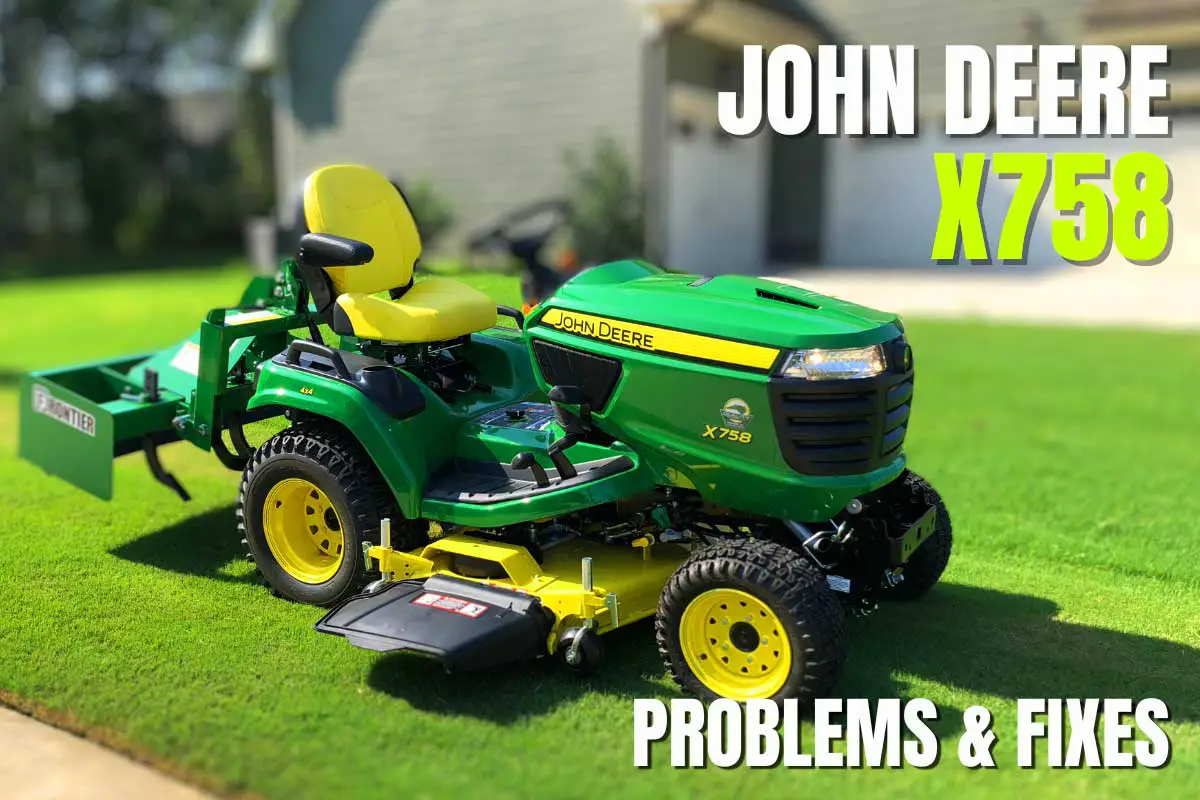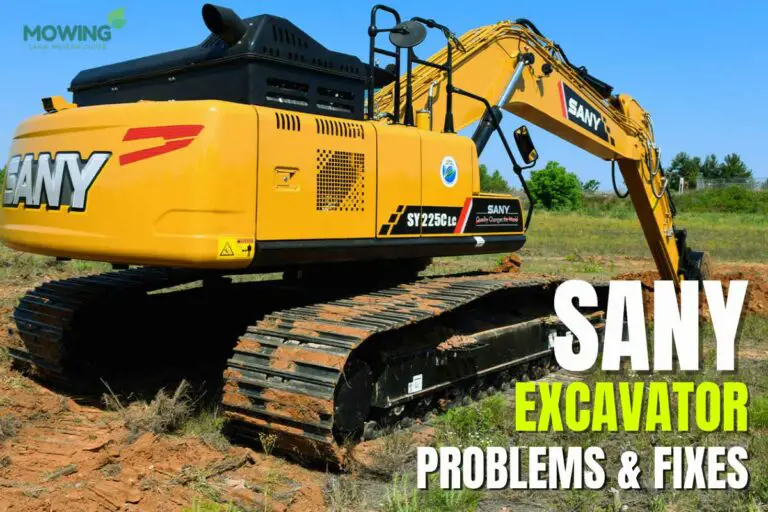
Are you struggling with John Deere X758 problems while operating this lawn utility tractor? Well, you are not alone, then. This fantastic addition to John Deere X700 Signature Series is supposed to be faultless. But the reality is different.
Many John Deere X758 owners claimed that working with this tractor is actually no bed of roses. It has several flaws that are frustrating to deal with. This article delves deep into some common problems faced by users.
We will provide practical solutions to fix them. By addressing problems, yourself, you can avoid expensive service calls. Understanding these problems and their fixes can save time, effort, and money for both seasoned users and newcomers.
What Are Common John Deere X758 Problems and How to Fix Them?
John Deere X758 is a renowned name in the gardening and landscaping world. It has been a choice for many due to its reliability. Despite being a stalwart in the gardening and landscaping industry, it is not exempt from its share of issues.
The common issues are starting difficulties, stalling, mechanical and electrical issues, overheating, rough-running engines, etc. Familiarizing yourself with these common problems can help you with timely troubleshooting and maintenance.
Problem 1: Starting Difficulties
The John Deere X758, as robust as it is, can sometimes give users a tough time when trying to start. There are a few reasons behind this. Firstly, a drained or weak battery can be a primary culprit.
A battery can wear out because of poor maintenance. If the battery isn’t supplying adequate power, the engine won’t crank. Secondly, cold weather can thicken the engine oil, making it more challenging to turn over the engine.
Another common issue lies in the fuel system. Stale fuel or a clogged fuel filter can impede the smooth flow required for ignition. An aged or faulty spark plug can prevent the engine from firing up.
Spark plugs clog cannot provide signals to the engine. Also, faulty or loose connections make spark plugs problematic. Carburetors regulate the amount of fuel during power production. It can become clogged and misbehave after prolonged use.
How to Fix Starting Difficulties?
Begin by inspecting the battery. Ensure the battery terminals are clean and free of corrosion. Consider a replacement if the battery is old or not holding a charge. Make sure the battery charge is above 12 volts.
Ensure the fuel in the tank is fresh. Refill the fuel tank regularly. Stale fuel can cause ignition issues. Note that fuel has a shelf life of 30 days before it becomes useless.
It’s a good practice to empty the tank if you plan to store the machine for extended periods.
Enough clean air is needed for proper engine operations. A clogged filter can restrict fuel flow. Check it for blockages and consider replacing it if it’s been in use for a while.
Remove the spark plug and inspect its condition. It might be time for a replacement if it’s sooty or eroded.
In colder climates, opt for thinner engine oil that won’t thicken as much in low temperatures, ensuring smoother starts.
If the spark plug is clogged with carbon residue buildup, clean the spark plug regularly. Also, check if the plug is connected correctly and not faulty or loose. Tighten the loose plugs and adjust the wrong connections.
If the carburetor is clogged, disassemble it and clean all the parts with a specialized cleaner. If the problem still remains, replace it.
Problem 2: Mechanical Issues
The John Deere X758, a powerhouse in its league, is prone to specific mechanical issues over its lifetime. A primary factor behind these issues is simple wear and tear. With regular use, parts undergo strain, leading to their gradual degradation.
Belts can become loose or frayed, and gears can wear down over time, affecting their efficiency. Moreover, inadequate maintenance can exacerbate these wear-related problems.
Skipping regular checks can allow small issues to escalate into significant malfunctions. Another cause is the accumulation of dirt and debris, primarily when the machine is used in dusty environments.
Such buildup can hinder moving parts, leading to decreased functionality. Other causes include excessive vibrations, incorrect belt placement, clogged discharge chutes, wrong alignment, and loose belts.
How to Fix Mechanical Issues?
After each use, especially in dusty conditions, clean the John Deere X758 thoroughly. Pay close attention to areas where dirt can get trapped.
Periodically inspect belts, gears, and other moving parts for signs of wear. Replace any components that show significant degradation.
Proper lubrication reduces friction and prevents premature wear of parts. Use recommended lubricants and grease for optimal performance.
While working on tall grass, you can avoid clogging the discharge chute by reducing the mower’s speed and deck height. Also, clean underneath the deck and avoid using it on wet grass. Make sure to keep the blades sharpened and balanced.
Check if the belts are correctly placed and they are tightened. If not, reinstall them.
Excessive vibration happens due to loose bolts and nuts. Tighten the bolts. Also, check for damaged components, such as; mandrels, blades, and pulleys, for smooth operation.
The belts and pulleys sometimes misalign, leading to mechanical issues. Make sure they are aligned.
If you notice any anomaly, address it immediately. Prolonging repairs can compound problems and lead to more extensive damage.
Read also: Common Kayo Fox 70 Problems And Easy Fixes
Problem 3: Electrical Issues
John Deere X758, while renowned for its performance, may sometimes encounter electrical glitches. One prevalent issue is a faulty ignition system, where the machine fails to start or stalls unexpectedly.
Wiring problems, corroded connectors, or damaged switches can also lead to intermittent electrical failures. Faulty fuses blow because electric shorts don’t offer overcurrent protection.
Battery problems, especially with an old or drained battery, can lead to inadequate power distribution. It affects the machine’s functionality. Also, malfunctioning sensors or blown fuses can result in many operational glitches.
How to Fix Electrical Issues?
Start with the battery. Ensure it’s charged and free from corrosion. Replace if it’s old or not holding a charge adequately.
Examine the machine’s wiring for any visible damages or wear. Repair or replace any frayed wires and ensure connectors are snug.
Test switches for proper operation. Replace any that are malfunctioning. Sensors, especially in modern models, should be checked and replaced if they send erratic signals.
Inspect the fuse box. Replace any blown fuses with the correct rating as specified by the manufacturer.
Inspect the belts and corroded cables and make sure they are not damaged. Replace the faulty belts and damaged cables.
Make sure the battery terminals are not clogged or damaged. If they are damaged, replace them immediately, as it restricts the smooth flow of electric current, affecting the tractor’s functionality.
If electrical issues persist or seem complex, consider seeking professional or authorized service center assistance.
Problem 4: Stalling
Stalling in the John Deere X758 can be attributed to several factors. Firstly, fuel-related issues are common culprits. Using old or contaminated fuel can hamper the engine’s ability to run smoothly.
A clogged fuel filter or malfunctioning carburetor can also disrupt the fuel supply, leading to stalling. Another factor is the air filter. If it becomes overly dirty or clogged, it can restrict airflow to the engine, causing it to stall.
Electrical issues, such as a faulty ignition system, can also be responsible. Leaking reduces the system’s fuel concentration, power production, and oil pressure. Lastly, any issues with the machine’s drivetrain or transmission can result in abrupt stops during operation.
How to Fix Stalling?
Always use fresh fuel, as contaminated fuel makes it too thick to flow. Thus, it reduces the amount of fuel reaching the engine. Flush out contaminated oil and refill it with a new one. Store any remaining fuel in a sealed container.
- Regularly replace the fuel filter and clean the carburetor to ensure optimal fuel flow.
- Examine the air filter often and replace or clean it if dirty. A clean air filter ensures efficient combustion.
- Ensure that the ignition system and other electrical components work well. Replace any worn-out parts or wires.
- To curb the leaking issues, check for faulty hoses and lines.
Regularly check and top up the transmission fluid. A smooth transmission system can prevent unexpected stalls.
Problem 5: Overheating
Overheating in the John Deere X758 is a concern that can arise from various factors. The leading cause of overheating is deck discharge placement. Another reason is a clogged or malfunctioning radiator, which can’t dissipate heat efficiently.
The coolant, if old or at an insufficient level, can also contribute to rising temperatures. Dirt and debris buildup around the engine can trap heat. It can prevent proper ventilation.
Furthermore, a faulty thermostat can misrelate the engine’s temperature, leading to overheating. Low coolant levels, overloading, and clogged radiators are other causes of overheating.
How to Fix Overheating?
Regularly clean the radiator fins and ensure there’s no blockage. This allows for efficient heat dissipation.
- Ensure the coolant is at the recommended level and replace it at intervals suggested by the manufacturer.
- If the engine overheats rapidly, the thermostat might be faulty. Consider replacing it to maintain the appropriate engine temperature.
- Periodically remove dirt and debris from around the engine to promote adequate ventilation.
Only load the tractor at most 1200 lbs to prevent overloading issues.
Problem 6: Steering Problems
The John Deere X758, while known for its durability, may occasionally face steering challenges. These can arise from worn-out steering components, leading to reduced maneuverability. Steering gears can wear down over time, affecting precision.
Additionally, low or contaminated hydraulic fluid can cause stiffness in steering. External factors, such as dirt or debris lodged in the steering mechanism, can also hamper smooth operation.
John Deere’s steering requires a certain fluid amount flowing through it for efficient operation. Inadequate fluid doesn’t produce enough force to turn the tractor. Also, a faulty pump cannot push enough fluid, making it difficult to steer.
How to Fix Steering Problems?
Regularly check steering gears and other parts for wear. Replace components that show evident degradation to ensure precise control.
Ensure that the hydraulic fluid is at the recommended level. If the fluid appears dirty or contaminated, flush it out and replace it with a new one.
Replace the faulty pump to maintain smooth steering responsiveness.
After usage, especially in dirty conditions, clean the steering components to ensure no debris obstructs the mechanism.
How to Maintain Your John Deere X758 for Longevity?
Proper maintenance and timely fixes can prolong the life of your John Deere X758. Below are maintenance tips to prevent larger malfunctions to the tractor:
- Start with regular oil changes, ensuring the engine runs smoothly.
- Periodically check and replace air and fuel filters in very two hundred hours to optimize combustion and fuel efficiency.
- Make sure to change the two transaxle filter every 50 to 200 hours.
- Keep an eye on hydraulic fluid levels, replenishing when necessary.
- Change the low viscosity Hy-guard every 50 to 200 hours.
- Inspect belts, hoses, and moving parts for signs of wear, replacing them as needed.
Finally, after every use, clean the machine thoroughly, removing dirt and debris that could hamper performance.
Final Thoughts: Making the Most of Your John Deere X758
The John Deere X758 is an investment in quality and performance. Although easy to fix, the John Deere X758 problems pose a significant threat. Whether electrical, mechanical, or steering-related, prompt resolution of issues ensures uninterrupted service.
Proactive maintenance is key to harnessing its full potential. A well-maintained John Deere X758 is a testament to efficiency, longevity, and superior performance. Stay diligent, and this powerhouse will serve you faithfully for years to come.






